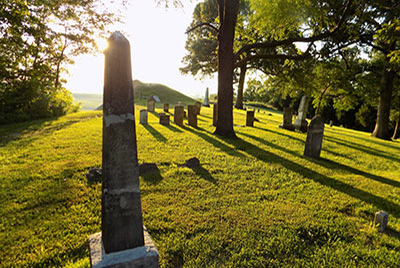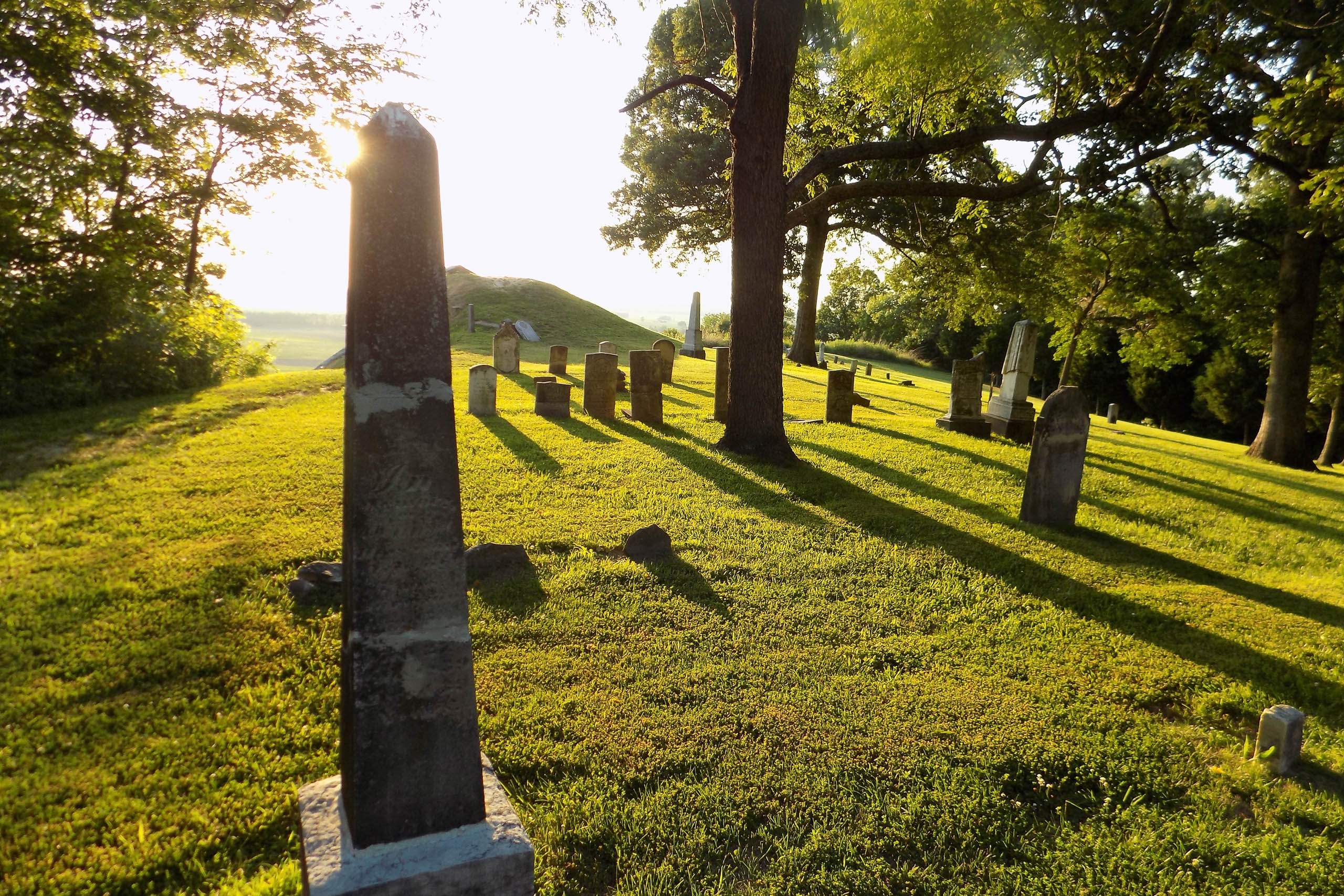



At a point where Bluff Road turns away from its eponymous bluff and follows a levee to the west, one can instead turn uphill and follow a series of small county roads (Hh Road, then D Road) a short way to the entrance of Eagle Cliff Cemetery. The cemetery entrance is easy to miss as it shares a driveway with a local farmhouse, but it is marked with a small stone monument bearing the cemetery’s name. The earliest burial dates from 1806, with the most recent being 1978. The cemetery is sited on a ridge along the bluff and offers an extraordinary park-like setting. At the far edge of the site and overlooking the American Bottom is a mausoleum—built in 1858 by Steven W. Miles and visible for miles across the bottom—housing 56 vaults. Recently cleaned of years of graffiti, it is now accessible to the public. This point, high on the edge of the bluff, offers one of the best views of the bottomland with its sharp-edged levees and agricultural patterns. The cemetery is open from dawn to dusk.
Restoration of the hallowed land of the cemetery compensated for the neglect of the resting places of dozens of early Monroe County settlers, ranging from eponymous land baron Stephen W. Miles to Revolutionary War veterans. The work also ratified J. B. Jackson’s assertion of the “necessity for ruins,” or the redemptive function of abandonment of historic sites that allows their restoration to serve the identitarian needs of later generations. Eagle Cliff is now a grand scenic overlook, enshrining Miles’ own boastful statement that he owned every acre within the view; a site for the veneration of an origination myth for Monroe County that places a white man instead of First Americans as an original settler; and a patriotic ground where veterans of a litany of foundational continental wars (Revolutionary, War of 1812, Civil) are interred. All of these functions are rooted in real history, of course, but withhold other histories: federal-sanctioned land speculation and Illinois’ contorted history of sanctioned slavery.
Born to Welsh parents and raised in Cazenovia, New York, Stephen W. Miles served in the War of 1812. Like many veterans, he received a land warrant for a tract in the Northwest Territory, but unlike others, he actually relocated to claim the land. In 1819, Miles arrived on the American Bottom and quickly embarked upon a profitable and successful speculative land purchase plan. Miles purchased the unclaimed or unwanted warrants of other veterans, and bought other lands, until he held 600 acres of fertile American Bottom farmland. Miles commandeered slave labor to clear his land, situating this Eastern settler in Illinois into the more contorted reaches of American patriotism. Stephen W. Miles’ reliance on slavery was hardly atypical for an ambitious Southern Illinois farmer and landowner, however.
At the time that Miles settled on the American Bottom, Illinois was rife with a contradictory constitution that forbade slavery but allowed five types of human bondage. Matthew Stanley describes the state as a “society with slaves” instead of a “slave society”—a state seemingly folded into a Northern way of life but retaining a clandestine dependence on Southern oppression. The tolerance of slavery actually had roots in the French colonial code noir, or “black laws,” of 1720, which opened Illinois to slavery. Although the Northwest Ordinance of 1787 outlawed slavery in the territory, it did not regulate leased slaves or indentured servants. The American Bottom was an arena for human bondage ahead of Miles: Phillippe Francois Renault brought leased slaves to work mines near present-day Renault in the late seventeenth century.
The permissiveness of slavery was debated in Illinois toward the time of Miles’ death in 1859, with passage of the exclusion law in 1853 preceding the Lincoln-Douglas debates in 1858. Illinois saw an emerging consensus that was against the last vestiges of slavery in the state but nonetheless hostile toward black citizenship. Miles’ own relationship to the enterprise of slavery at his death is unknown, but he did retain indentured servants. Miles would bury an indentured servant in his great mausoleum, and bequeath part of his estate to another in his will.
Excerpted from: Michael R. Allen, "Intangible Heritage on the American Bottom"